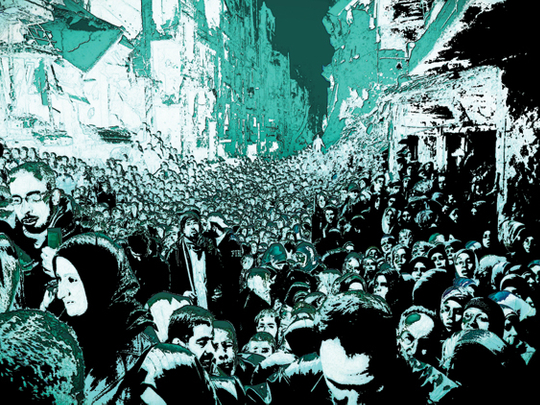
In late February, roughly two weeks before the war in Syria entered its fourth year, the Associated Press (AP) distributed the United Nations’ “Yarmouk photo”, showing the gut-wrenching image of a sea of humanity, mostly desperately hungry Palestinians in their bomb-ravaged refugee camp outside Damascus, scrambling for food handouts.
The striking photo not only spoke about the unspeakable suffering of civilians — victims of the regime’s embrace of starvation as a tactic, of starvation until submission, as it were but it also spoke about us, about the need to “do something”. So far, 130 humanitarian organisations, including major UN agencies, have plans to display the photo on a giant screen in Times Square, New York. Better than doing nothing, isn’t it? But will it make a difference? Will it in any way block or impede efforts by Syria’s president to continue mauling his people? Beyond its worth of a thousand words, will the photo be seen by those who view it as a call to arms, if only figuratively?
Critics of photojournalism, including literary theorists like Susan Sontag in her seminal work On Photography (1977), along with its sequel two years later, On the Pain of Others, and Roland Barthe’s Camera Lucida (1980), have questioned the idea that vivid imagery of human suffering can trigger in us the impulse for political activism. Sure, they argue, the viewers’ initial reaction is shock, but then the collateral shock they sense at their own moral inadequacy deflates their feelings of outrage. These critics have even further argued that the effusions of photojournalism as a craft, depicting cruelty and political violence, exploit their subject and pander to the voyeuristic inclinations in all of us. While it is true that shocking images of contemporary warfare leave us with an inescapable feeling of outrage, we become inured to that feeling as ever more explicit photos assault our senses, and our responses become more muted, more muddled.
New critics argue that people like Susie Linfield and Michelle Borge, in their recent works, The Cruel Radiance: Photography and Political Violence and Photography As Activism: Images for Social Change, respectively, pander to the sensibility of those among us who have long believed that photography is a serious art form, that in its manifestation as photojournalism helps us see behind the picture, to probe our conscience, our capacity for compassion, to be viscerally affected. Thus, good photojournalism makes an eloquent statement about our condition and invites us to ask morally pertinent, even unsettling, questions. And maybe go out there and make a difference.
To look at pictures like the Yarmouk photo, for example, is an act that connects us to our modern history in this small global village we all inhabit together, that compels us to examine our human penchant for cruelty. And to view — contemplate — a photo’s narrative, its thousand words, on a giant screen in Times Square, has the potential, if only subliminally, to make us think together, to draw from each other a communal sense of reference. Suddenly we are not looking at the suffering of a nameless, faceless people, victims of a nihilistic faraway war. These starving Palestinians become our brothers and sisters under the skin. And, yes, pictures do change our view of objective reality, and thus our condition, our history.
Almost exactly 10 years ago, on March 31, 2004, Khalid Mohammad, an Iraqi photojournalist for AP, had taken a picture of the burnt, mutilated bodies of US contractors hanging from a bridge in Fallujah, surrounded by a crowd of cheering Iraqis. The picture was powerful because, among other things, it drew on the contrast between the celebration of the jubilant crowd and the horror of the dangling bodies. The 2004 presidential election was seven months away and commentators wondered whether the photo was president George W. Bush’s “Somalia moment”. It was not, but it drove the public debate about the war and how it was later covered by the print media. Consider how similarly iconic photos over the years remain seared in our minds: The 12-year-old Mohammad Al Durrah, filmed by freelance photographer Talal Abu Rahma in a one-minute clip, as he and his father sought cover behind a concrete cylinder to escape being caught in the crossfire — the pair holding on to each other. Then a burst of gunfire, followed by that image of the boy slumped across his father’s lap.
What helped galvanise the anti-war sentiment against the war in Vietnam? That South Vietnamese police chief summarily executing a Vietcong soldier during the Tet Offensive in 1968. What drove people to help alleviate the dreadful plight of migrant workers during the Great Depression in the US? Dorothea Lange’s photos about the unbelievable suffering of these impoverished Americans. What gave credence to the nascent environmental movement in the 1950s? The stunning black-and-white landscape photos of the despoiled American West by Ansel Adams.
An so it goes with countless other photos by photojournalists who have taken their craft so seriously that they helped elevate it, since its inception in the 1820s, to an art form comparable with painting, music and poetry.
The Yarmouk photo? The story it tells will endure, and as it endures it will edify. Its message will be the one that Martin Luther King delivered to us before he was shot and killed in 1968. “The ultimate tragedy is not the oppression and cruelty by the bad people”, he said, “but the silence over that by the good people.”
Fawaz Turki is a journalist, lecturer and author based in Washington. He is the author of The Disinherited: Journal of a Palestinian Exile.










